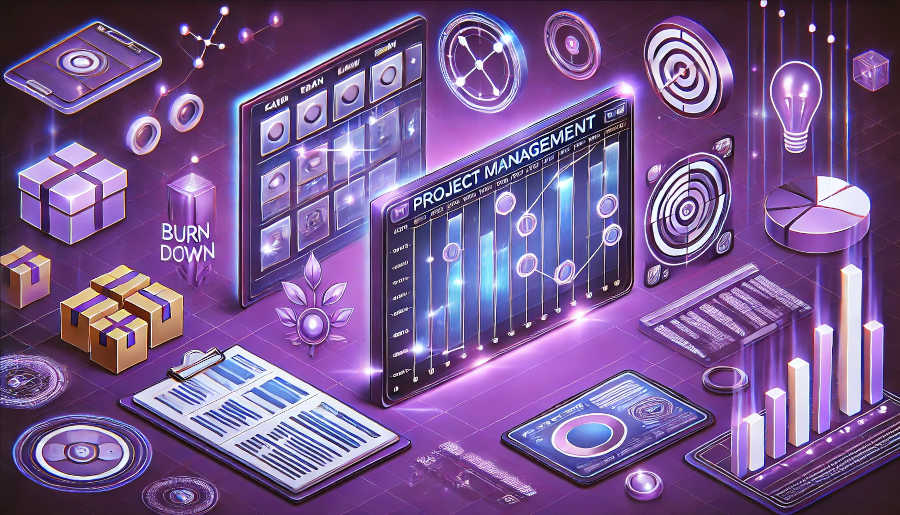Definition and Purpose of Milestones
Milestones in a project are not just random events but carefully selected markers that signify important achievements. They are distinct, measurable, and time - bound events that represent a significant stage in the project lifecycle. For example, in a software development project, milestones could include the completion of the requirements gathering phase, the release of a beta version, or the final product launch. The purpose of setting milestones is multi - fold. Firstly, they provide a clear sense of direction for the project team. By knowing what specific goals need to be achieved at different points in time, team members can align their efforts and work towards a common purpose. Secondly, milestones help in communicating the project's progress to stakeholders. Stakeholders, such as clients, investors, or senior management, can easily understand how far the project has advanced by referring to these milestones. This transparency builds trust and confidence in the project's management. Finally, milestones are useful for risk management. If a milestone is not met on time, it can be an early indicator of potential problems in the project, allowing for timely corrective actions.
Milestones also serve as motivation for the project team. Achieving a milestone gives a sense of accomplishment, boosting team morale and productivity. When team members can see their hard work resulting in tangible achievements, they are more likely to stay engaged and committed to the project. Moreover, milestones help in breaking down a large and complex project into smaller, more manageable parts. This makes it easier to plan, execute, and control the project. For instance, in a construction project, milestones like the completion of the foundation, the erection of the building structure, and the installation of utilities provide clear phases of work. Each milestone can be further broken down into tasks, and resources can be allocated accordingly. This hierarchical approach to project management ensures that nothing is overlooked and that the project progresses smoothly.
In addition, milestones play a vital role in resource allocation. By knowing when certain milestones need to be achieved, project managers can allocate resources effectively. For example, if a milestone requires a specific set of skills or a particular amount of equipment, the project manager can ensure that these resources are available at the right time. This helps in optimizing resource utilization and avoiding unnecessary delays or cost overruns. Milestones also assist in setting realistic deadlines for the project. They provide a framework for estimating the overall project duration and help in creating a project schedule that is both achievable and efficient.
Characteristics of Effective Milestones
Effective milestones possess several key characteristics. Firstly, they are specific. A milestone should be clearly defined, leaving no room for ambiguity. For example, instead of a vague milestone like "Improve system performance," a more specific milestone would be "Reduce system response time by 50% within the next two months." This specificity allows the project team to understand exactly what needs to be accomplished and how success will be measured. Secondly, milestones are measurable. There should be a clear way to determine whether a milestone has been achieved or not. This could involve metrics such as completion percentage, quality standards, or time taken. For instance, in a marketing campaign project, a milestone could be "Generate 10,000 leads within the first quarter," where the number of leads is a measurable metric.
Another important characteristic of effective milestones is that they are achievable. While it is important to set ambitious goals, milestones should be within the realm of possibility given the available resources, time, and skills. Unrealistic milestones can demotivate the project team and lead to frustration. For example, if a software development team is given a milestone to develop a complex new feature in a week when it realistically requires two weeks, it is likely that the milestone will not be met. Milestones should also be relevant to the project's overall objectives. They should contribute directly to the achievement of the project's goals. For example, in a product launch project, a milestone related to packaging design should be relevant to the overall goal of successfully introducing the product to the market.
Finally, milestones are time - bound. They have a specific deadline attached to them. This time constraint helps in creating a sense of urgency and focus within the project team. Without a deadline, there is a risk of tasks dragging on indefinitely. For example, a milestone to complete a market research report should have a set date, say, "Submit the market research report by the end of the month." This time - bound nature of milestones also helps in tracking progress and holding the project team accountable.
Identification and Selection of Milestones
Identifying and selecting the right milestones is a critical step in creating a project milestone plan. It requires a deep understanding of the project scope, objectives, and the project lifecycle. One approach is to start with the project's end goal and work backwards. For example, if the project goal is to launch a new mobile application, the final milestone would be the app's release. Then, break down the steps leading to this goal into smaller milestones. These could include the completion of the app's design, the development of key features, and the successful completion of testing phases. Another way is to look at the natural breaks or transitions in the project. In a construction project, the different phases of construction, such as excavation, building erection, and finishing, can be identified as milestones.

When selecting milestones, it is important to involve all relevant stakeholders. The project team, clients, and subject matter experts can all provide valuable insights. The project team has hands - on knowledge of the tasks involved and can identify key points where significant progress is made. Clients can offer their perspective on what they consider important achievements in the project. Subject matter experts can bring in their specialized knowledge to ensure that the milestones are technically feasible and relevant. For example, in a medical research project, involving medical doctors and researchers in the milestone selection process can help in identifying important stages such as the completion of clinical trials or the publication of research findings.
It is also important to consider the dependencies between milestones. Some milestones may be dependent on the completion of others. For example, in a software development project, the testing milestone cannot start until the development of the software is complete. Understanding these dependencies helps in creating a logical sequence of milestones and ensures that the project progresses smoothly. Additionally, when selecting milestones, it is advisable to keep them at a reasonable number. Too many milestones can make the plan overly complex and difficult to manage, while too few may not provide enough visibility into the project's progress. A good rule of thumb is to select milestones that provide sufficient checkpoints without overwhelming the project team.
Integration with Project Schedule and Budget
A project milestone plan should be closely integrated with the project schedule and budget. The schedule defines the timeline for each task and milestone, while the budget allocates the necessary resources to achieve them. When creating the project schedule, the milestones act as anchor points. The tasks leading up to each milestone are scheduled in a way that ensures the milestone can be reached on time. For example, if a milestone in a product development project is to have a prototype ready in three months, the tasks related to design, material sourcing, and initial manufacturing should be scheduled in such a way that they are completed within this time frame. This integration helps in ensuring that the project progresses in an orderly manner and that there are no unnecessary delays.
The budget is also closely tied to the milestones. Each milestone may require a certain amount of resources, including labor, materials, and equipment. By aligning the budget with the milestones, project managers can ensure that the necessary funds are available when needed. For example, if a milestone involves the purchase of specialized equipment, the budget should allocate the appropriate amount for this purchase. This integration helps in controlling costs and avoiding budget overruns. If a milestone is not achieved as planned, it can have an impact on both the schedule and the budget. Delays in reaching a milestone may require additional resources to catch up, which can increase costs. On the other hand, cost overruns can also lead to delays if there are not enough funds to complete the tasks required to reach the milestone.
Moreover, the integration of the milestone plan with the schedule and budget allows for better monitoring and control. Project managers can compare the actual progress of the project against the planned milestones, schedule, and budget. If there are any deviations, corrective actions can be taken promptly. For example, if a milestone is behind schedule, the project manager can analyze the reasons, such as resource shortages or unexpected technical problems, and take steps to address them. Similarly, if the budget for a milestone is being exceeded, the project manager can look for ways to cut costs without sacrificing the quality of the work.
Monitoring and Controlling Milestones
Once the project milestone plan is in place, it is essential to monitor and control the milestones effectively. Monitoring involves regularly tracking the progress of the project towards each milestone. This can be done through various means, such as status reports, team meetings, and project management tools. Status reports provide a snapshot of the project's progress, indicating whether a milestone is on track, behind schedule, or ahead of schedule. Team meetings allow for face - face communication, where team members can discuss any issues or challenges they are facing in achieving the milestones. Project management tools, such as Gantt charts or task management software, can also be used to visually track the progress of the project and the milestones.
When monitoring milestones, it is important to look for early warning signs of potential problems. For example, if a task that is critical for a milestone is taking longer than expected, it could be an indication that the milestone may be at risk. In such cases, the project manager should take immediate action to address the issue. This could involve reallocating resources, providing additional training to the team members, or adjusting the project schedule. Controlling the milestones also involves making decisions to ensure that the project stays on track. If a milestone is not achieved as planned, the project manager needs to determine whether to revise the milestone, the schedule, or the budget. For example, if a milestone was not met due to unforeseen circumstances, such as a natural disaster that disrupted the supply chain, the project manager may need to extend the deadline for the milestone and adjust the subsequent schedule accordingly.
In addition, monitoring and controlling milestones also involve communicating the progress to stakeholders. Stakeholders need to be kept informed about the project's status, especially when it comes to the achievement of milestones. This communication can be in the form of regular reports, presentations, or meetings. By keeping stakeholders informed, the project manager can manage their expectations and gain their support in case any changes or adjustments need to be made to the project. Effective monitoring and control of milestones are essential for ensuring the successful delivery of the project.
In conclusion, a well - crafted project milestone plan is the cornerstone of successful project management. The key elements of a milestone plan, including the definition and purpose of milestones, their characteristics, identification and selection, integration with the schedule and budget, and monitoring and control, all work together to ensure that the project progresses smoothly towards its goals. By understanding and implementing these key elements, project managers can enhance the visibility, control, and success of their projects. Milestones provide a clear roadmap for the project team, help in communicating progress to stakeholders, and enable effective risk management. They also play a crucial role in resource allocation and ensuring that the project is completed within the specified time and budget. In the dynamic world of project management,
ARTICLE TITLE :Analysis of key elements of project milestone plan ,AUTHOR :ITpmlib

















